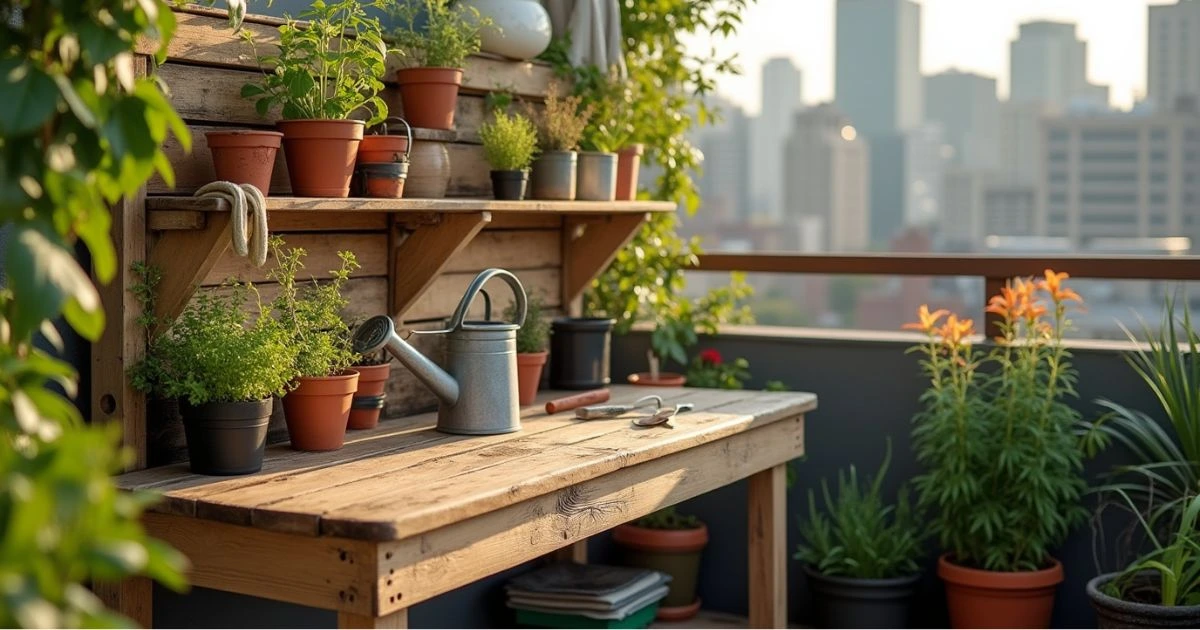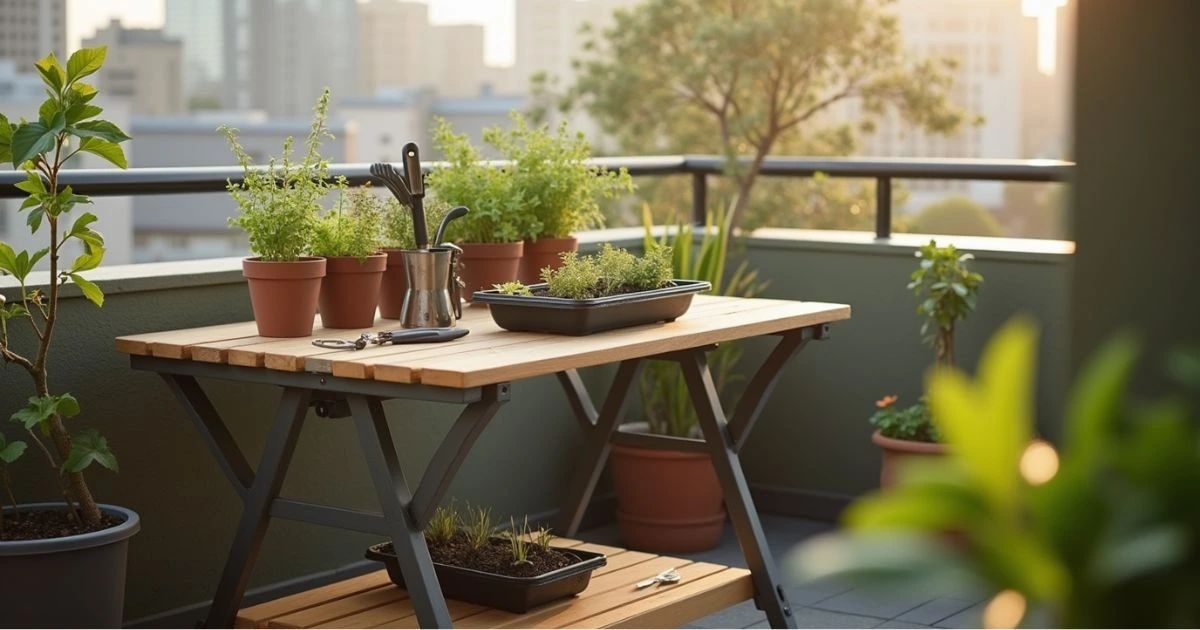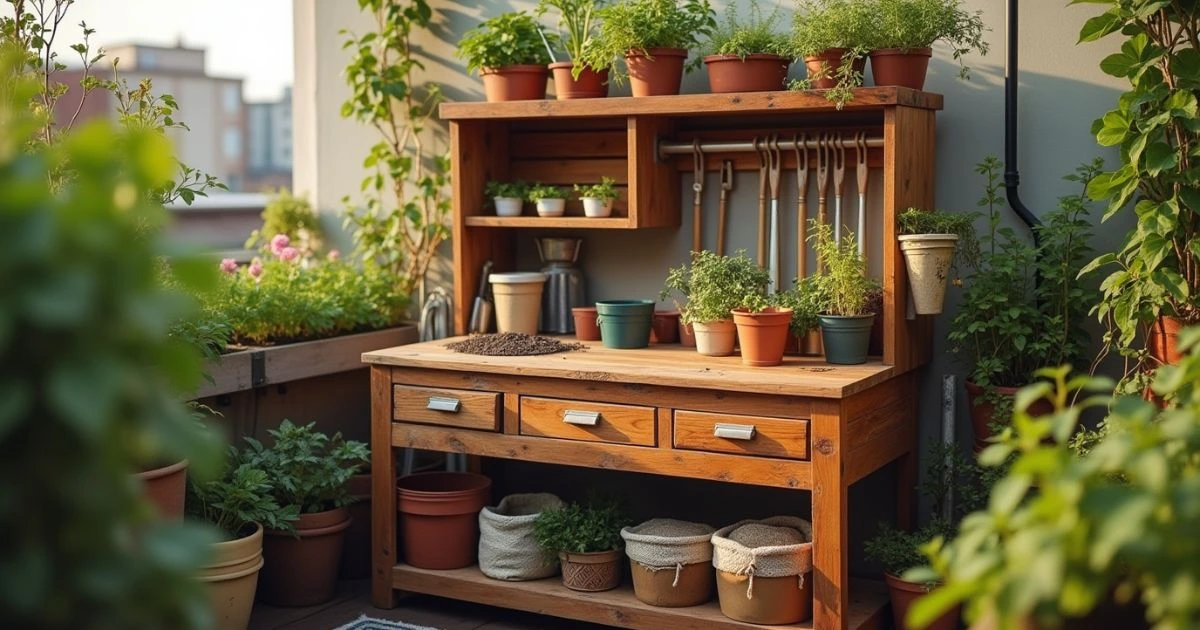Gardening on a rooftop is an exhilarating way to bring nature into even the smallest urban spaces. But to make the most of a rooftop garden, you need an organized, functional workspace. A DIY potting bench offers the perfect solution. Building your own potting bench not only saves you money, but also allows you to customize it to your space, needs, and style. Whether you’re a seasoned gardener or just starting out, a DIY potting bench can transform your rooftop into a thriving, green oasis. This guide offers five simple potting bench ideas and plenty of tips to get you inspired.
Table of Contents
Why a DIY Potting Bench is Perfect for Rooftop Gardens
Rooftop gardens come with their own set of challenges. Limited space, exposure to weather, and a lack of traditional garden storage can make gardening on a rooftop tricky. This is where a do it yourself potting bench shines. Potting benches provide an organized space to keep your gardening essentials in one place, protect plants during potting and transplanting, and add a functional yet aesthetic touch to your garden. Building a potting bench yourself offers flexibility—you can choose the materials, height, and size that best fit your rooftop.
5 Brilliant DIY Potting Bench Ideas for Rooftop Gardens
Each of the following ideas is designed with rooftop gardening in mind. From space-saving foldable benches to multi-functional options with storage, these DIY projects will help you create the perfect potting bench for your outdoor space.
1. Repurposed Wood Potting Bench

One of the easiest ways to start your DIY project is by using reclaimed wood. Not only is it budget-friendly, but it also gives your potting bench a charming, rustic look that’s eco-friendly too.
- Materials Needed: Reclaimed wood planks, nails, wood screws, and waterproof sealant.
- Steps:
- Cut the wood planks to your preferred size.
- Assemble a simple frame for stability.
- Attach additional planks to form the bench surface.
- Seal the wood with a waterproof coating to prevent weather damage.
- Benefits: Reclaimed wood potting benches are sturdy, environmentally friendly, and can be customized to fit any rooftop.
2. Foldable Potting Bench for Small Spaces

For a rooftop with limited space, a foldable potting bench is a lifesaver. You can tuck it away when not in use, freeing up room for other activities or plants.
- Materials Needed: Wooden planks, hinges, screws, and a locking mechanism.
- Steps:
- Construct a simple tabletop that can fold against the wall when not in use.
- Install hinges for easy folding and a lock to keep it in place.
- Benefits: This design is perfect for rooftops with space constraints. You get the functionality of a potting bench without sacrificing precious room on your rooftop.
3. Vertical Potting Bench with Storage Shelves

Maximize vertical space by adding storage shelves to your potting bench. This design allows you to organize tools, pots, and soil bags neatly while keeping your workspace clear.
- Materials Needed: Wooden boards, screws, brackets, and hooks.
- Steps:
- Build a standard potting bench base.
- Attach shelves above the bench for extra storage.
- Add hooks along the sides for tools and accessories.
- Benefits: With this vertical potting bench, you can keep your garden supplies organized and easy to access, ideal for smaller rooftop setups.
4. Potting Bench with Built-In Planters

Why not combine your workbench with actual planting space? A potting bench with built-in planters gives you a spot to pot plants while keeping additional plants nearby.
- Materials Needed: Cedar wood, planter boxes, screws, and potting soil.
- Steps:
- Construct a sturdy base for your potting bench.
- Cut spaces in the top surface to hold planter boxes securely.
- Fill the boxes with soil and add your plants.
- Benefits: This design is both practical and beautiful, allowing you to integrate plants directly into your workbench. Perfect for rooftop gardeners looking to maximize plant space.
5. Portable Potting Bench with Wheels

For those who want flexibility, a portable potting bench with wheels lets you move your gardening station as needed. This feature is especially useful on a rooftop where sunlight and shade shift throughout the day.
- Materials Needed: Wooden planks, heavy-duty wheels, screws, and handles.
- Steps:
- Build a standard potting bench.
- Attach wheels to the legs for mobility.
- Add a handle for easier maneuvering.
- Benefits: Portability adds versatility to your rooftop setup. This bench can be moved around to accommodate light changes or to make room for other activities.
Essential Tips for DIY Potting Bench Construction
When building a potting bench, consider factors specific to rooftop gardens. Here are some key tips to help your project succeed.
Choose Weather-Resistant Materials
Since your potting bench will be exposed to weather, choose materials like cedar, treated wood, or metal that can withstand rain, sun, and wind. Applying a waterproof sealant to wooden surfaces will extend the life of your bench.
Add Storage for Rooftop Gardening Tools
Small storage compartments, hooks, and bins are invaluable on a rooftop. Adding these features to your bench keeps your tools, soil, and supplies organized and protected from the elements.
Consider Weight and Stability
Rooftop setups require a stable, well-anchored bench. Choose lightweight yet sturdy materials to avoid putting too much weight on your rooftop. Ensure stability by anchoring your bench to a wall or using anti-slip pads on the legs.
Must-Have Accessories for a Functional Potting Bench
In addition to the bench itself, certain accessories can enhance your rooftop gardening experience.
- Storage Bins and Trays: Perfect for organizing small tools, seeds, and soil.
- Tool Holders: Keep your gardening essentials within arm’s reach by adding a tool holder or small rack.
- Weatherproof Cover: A cover will protect your bench from rain and UV damage, preserving its appearance and durability.
Rooftop-Friendly Plants to Grow on Your Potting Bench
Choosing the right plants for your rooftop garden is key to a thriving setup. Here are a few types that do particularly well in rooftop conditions.
Herbs
- Herbs like basil, mint, and rosemary thrive in smaller spaces and pots. They’re easy to maintain and offer practical benefits for cooking.
Vegetables
- Rooftops can be a great spot for vegetables like cherry tomatoes, lettuce, and radishes. These plants don’t require deep soil and can grow in limited space.
Flowers
- Brighten up your rooftop with hardy flowering plants like marigolds, petunias, and zinnias. These flowers are sun-loving and add a vibrant touch to your garden.
Maintenance Tips for Your DIY Potting Bench
Regular maintenance will keep your potting bench looking great and functioning well. Here are some tips:
Protect Against Weather
Use a waterproof sealant, especially if you’re using wood, to guard against rain and sunlight. A cover will also help extend the life of your bench.
Regular Cleaning Tips
Cleaning your bench regularly prevents soil buildup and keeps it in good condition. A simple wipe-down after each use and a more thorough clean each month will make a big difference.
Seasonal Maintenance Checklist
- Spring: Refresh any protective coatings, clean thoroughly.
- Summer: Ensure stability as the bench may expand with heat.
- Fall: Cover or store indoors if possible.
- Winter: If left outside, ensure it’s protected with a durable cover.
A DIY potting bench is an invaluable addition to any rooftop garden. It combines functionality with aesthetics, helping you stay organized while enhancing the look of your space. With these five simple DIY ideas, you can build a potting bench that meets your needs and fits your rooftop garden’s unique challenges. So grab your tools, gather your materials, and get started on a project that will transform your gardening experience.
FAQ Section
What materials are best for a DIY potting bench on a rooftop?
Choose weather-resistant materials like cedar, treated wood, or metal for durability. Applying a waterproof sealant can further protect the bench from the elements.
How do I protect my potting bench from the weather?
Use a waterproof sealant and a protective cover. Covering it when not in use will help prolong the bench’s life and maintain its appearance.
Can I add built-in planters to my potting bench?
Yes! Built-in planters are a great addition and can be incorporated into the design for added functionality and aesthetics.
What are the benefits of a foldable potting bench for rooftops?
A foldable design saves space, making it perfect for rooftops where every inch counts. It allows you to have a functional work surface that can be stored easily.
How do I ensure my potting bench is stable on a rooftop?
Ensure stability by choosing lightweight but sturdy materials. Adding anti-slip pads to the legs or anchoring the bench to a wall can prevent tipping.
Ready to create your perfect DIY potting bench? Start planning your project today! With a little creativity and these five ideas, you’ll soon have a potting bench that transforms your rooftop into a beautiful, functional garden space.


